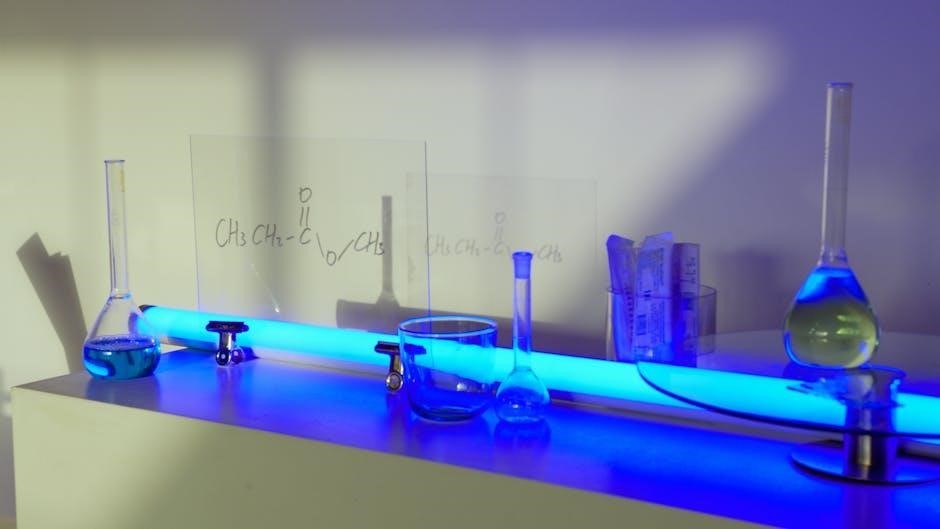This Chapter 5 Study Guide Chemistry covers essential topics like energy‚ matter‚ thermodynamics‚ and calorimetry. It explains thermal energy‚ specific heat‚ and Hess’s Law‚ while exploring enthalpy changes and the periodic table trends.
1.1 Energy and Matter
In chemistry‚ energy is defined as the capacity to do work‚ such as applying a force to move matter. It exists in two main forms: kinetic and potential. Kinetic energy is the energy of motion‚ while potential energy is stored energy due to an object’s position‚ composition‚ or condition. The law of conservation of energy states that energy cannot be created or destroyed; it can only be transformed from one form to another. Matter‚ on the other hand‚ refers to any substance that has mass and occupies space. The relationship between energy and matter is central to understanding chemical processes‚ as energy changes often accompany transformations in matter. For instance‚ thermal energy is associated with the motion of particles in matter‚ and chemical reactions involve energy absorption or release. Understanding these concepts is fundamental to analyzing energy transfer and storage in various systems.
1.2 Kinetic and Potential Energy
Energy exists in two primary forms: kinetic energy and potential energy. Kinetic energy is the energy an object possesses due to its motion. For example‚ a rolling ball or moving molecules exhibit kinetic energy. It is calculated using the formula ( KE = rac{1}{2}mv^2 )‚ where ( m ) is mass and ( v ) is velocity. On the other hand‚ potential energy is stored energy‚ which depends on the object’s position‚ composition‚ or condition. It can be gravitational (e.g.‚ water stored behind a dam)‚ elastic (e.g.‚ a stretched rubber band)‚ or chemical (e.g.‚ energy stored in bonds). When an object moves or a force acts on it‚ energy transforms between kinetic and potential forms. Understanding these concepts is crucial for analyzing energy changes in chemical and physical processes‚ such as phase changes or reactions‚ where energy is transferred or stored.
1.3 Law of Conservation of Energy
The Law of Conservation of Energy states that energy cannot be created or destroyed‚ only transformed from one form to another. This principle‚ also known as the first law of thermodynamics‚ applies universally to all physical and chemical processes. For instance‚ when a ball is dropped‚ its potential energy converts to kinetic energy as it falls. In chemical reactions‚ energy may be absorbed or released‚ but the total energy remains constant. This law is fundamental in understanding thermodynamic systems‚ as it ensures energy is balanced in any process. For example‚ in an exothermic reaction‚ heat is released to the surroundings‚ while in an endothermic reaction‚ heat is absorbed. By applying this law‚ chemists can calculate energy changes and predict the feasibility of reactions‚ making it a cornerstone of energy analysis in chemistry.

Thermal Energy and Calorimetry
Thermal energy arises from the motion of particles in matter. Calorimetry measures heat transfer during chemical or physical changes‚ using devices like calorimeters to determine specific heat capacities and energy transformations.
2.1 Understanding Thermal Energy
Thermal energy is the total internal kinetic and potential energy of particles in a substance due to their random motion. It depends on the mass‚ material‚ and temperature of the object. Temperature reflects the average kinetic energy of particles‚ so higher temperatures mean greater thermal energy. When thermal energy is transferred between objects or systems‚ it is called heat‚ moving from areas of higher to lower temperature. Understanding thermal energy is crucial for analyzing chemical processes‚ phase changes‚ and energy transformations. This section explores how thermal energy relates to molecular motion‚ temperature‚ and heat transfer‚ providing a foundation for calorimetry and thermodynamic principles. Grasping these concepts aids in calculating energy changes and predicting system behaviors in various chemical reactions and physical processes.
2.2 Principles of Calorimetry
Calorimetry is a scientific technique used to measure the thermal energy changes during physical or chemical processes. It involves the use of a calorimeter‚ a device designed to isolate a system and measure the heat exchanged with its surroundings. The principle relies on the relationship between heat transfer‚ mass‚ temperature change‚ and specific heat capacity. By monitoring temperature changes before and after a process‚ the amount of heat absorbed or released can be calculated using the formula: q = m × c × ΔT‚ where q is the heat‚ m is the mass‚ c is the specific heat‚ and ΔT is the temperature change. Calorimetry is essential for studying energy transformations‚ such as determining the heat of reactions or phase changes. It provides precise data on how energy is absorbed or released‚ making it a fundamental tool in thermodynamics and chemistry.

2.3 Heat Capacity and Specific Heat
Heat capacity and specific heat are critical concepts in thermodynamics‚ measuring how much heat energy is required to change the temperature of a substance. Heat capacity refers to the amount of heat needed to raise the temperature of an entire object or sample by 1 degree Celsius (or Kelvin). In contrast‚ specific heat is the amount of heat required to raise the temperature of one gram of a substance by 1 degree Celsius. The formula q = m × c × ΔT connects these concepts‚ where q is the heat absorbed or released‚ m is the mass‚ c is the specific heat‚ and ΔT is the temperature change. Substances like water have a high specific heat‚ meaning they absorb significant energy without large temperature changes‚ while metals have low specific heat‚ heating up quickly. Understanding these properties is vital for calculating energy changes in chemical reactions and physical processes.
Enthalpy and Enthalpy Changes involve the total energy of a system at constant pressure. Enthalpy change (ΔH) indicates if a reaction is exothermic or endothermic‚ guiding thermodynamic calculations and energy transfers.
3.1 Definition of Enthalpy
Enthalpy (H) is a thermodynamic property representing the total energy of a system at constant pressure. It combines internal energy (U) with the pressure-volume product (PV)‚ defined as H = U + PV. Enthalpy change (ΔH) measures the energy change during a chemical reaction at constant pressure‚ making it a crucial concept in chemodynamics. A positive ΔH indicates an endothermic reaction (absorbs heat)‚ while a negative ΔH signifies an exothermic reaction (releases heat). The standard enthalpy of formation (ΔHf°) is the change when one mole of a compound forms from its elements in their standard states. Enthalpy is widely used in calorimetry and thermodynamic calculations‚ providing insights into reaction spontaneity and energy transfer. Understanding enthalpy is essential for analyzing chemical processes and their energy interactions under various conditions.
3.2 Hess’s Law and Enthalpy Calculations
Hess’s Law states that the total enthalpy change of a chemical reaction is the same‚ regardless of the number of steps or the pathway taken to reach the final products from the reactants. This principle allows chemists to calculate the overall enthalpy change (ΔH°) of a reaction by summing the enthalpy changes of individual steps. It is particularly useful when direct measurement of a reaction’s enthalpy change is challenging. For example‚ if a reaction can be broken into two or more intermediate steps‚ the enthalpy changes of these steps are added to determine the overall ΔH°. Hess’s Law is a foundational tool in thermodynamics‚ enabling the determination of enthalpy changes for complex reactions using known values from simpler processes. This approach simplifies the calculation of enthalpy changes and is widely applied in chemical research and education.
3.3 Standard Enthalpy of Formation

The Standard Enthalpy of Formation (ΔHf°) is the change in enthalpy when one mole of a substance is formed from its elements in their standard states under standard conditions (1 atm‚ 25°C). It serves as a reference point for calculating enthalpy changes in chemical reactions. By definition‚ the standard enthalpy of formation of elements in their most stable form is zero. This concept is crucial for determining the enthalpy change (ΔH°) of a reaction using Hess’s Law‚ which involves summing the ΔHf° values of reactants and products. Negative ΔHf° values indicate exothermic formation (releases energy)‚ while positive values indicate endothermic formation (absorbs energy). These values are tabulated and used extensively in thermodynamic calculations to predict the spontaneity and energy changes of reactions. Understanding ΔHf° is essential for analyzing chemical reactions and their energy transformations.
Applications of Thermodynamics explore energy changes in chemical reactions‚ thermal energy transfer‚ and the use of devices like bomb calorimeters to measure energy content‚ linking theory to practical uses.
4.1 Energy Changes in Chemical Reactions
Energy Changes in Chemical Reactions are fundamental to understanding thermodynamics. Chemical reactions involve the absorption or release of energy‚ classified as endothermic or exothermic. Endothermic reactions absorb heat‚ while exothermic reactions release heat. These energy changes are measured using calorimetry‚ which quantifies heat transfer. The law of conservation of energy ensures that energy is neither created nor destroyed in a reaction. Enthalpy (ΔH) represents the total energy change at constant pressure. Positive ΔH indicates endothermic processes‚ while negative ΔH signifies exothermic processes. Hess’s Law allows the calculation of enthalpy changes for complex reactions by breaking them into steps. Understanding these concepts is crucial for predicting reaction outcomes and optimizing energy use in various applications.

4.2 Measuring Thermal Energy Transfer
Measuring Thermal Energy Transfer involves techniques like calorimetry to quantify heat exchange during chemical or physical processes. Calorimeters are insulated devices that minimize energy loss to the surroundings. The fundamental principle is q = mcΔT‚ where heat (q) depends on mass (m)‚ specific heat capacity (c)‚ and temperature change (ΔT). Bomb calorimeters are used for reactions at constant volume‚ while coffee cup calorimeters are simpler setups for constant pressure processes. Accurate measurements require precise temperature monitoring and control of external heat exchange. These methods are essential for determining enthalpy changes‚ heat capacity‚ and energy transformations in reactions‚ providing insights into the thermodynamic properties of substances.
4.3 Bomb Calorimeters and Their Use
Bomb calorimeters are specialized devices used to measure the heat of combustion of substances at constant volume. They consist of a sealed chamber where the sample is combusted‚ surrounded by water to absorb the released heat. The temperature change in the water is measured to calculate the heat of reaction using the formula q = mcΔT. These calorimeters are ideal for determining the energy content of foods and fuels. They operate under high pressure and are well-insulated to minimize heat loss‚ ensuring accurate measurements. Bomb calorimeters are widely used in research and industry for studying thermodynamic properties and energy transformations. Their precision makes them essential for understanding combustion reactions and energy release processes. They are particularly useful for reactions that produce gases‚ as the sealed environment contains the products effectively.

The Periodic Law and Periodic Table
The periodic law states that elements exhibit recurring properties at regular intervals when arranged by atomic weight. Mendeleev’s periodic table organizes elements systematically‚ revealing periodic trends in properties like atomic radius and reactivity. This framework predicts chemical behavior based on an element’s position‚ making it a foundational tool in chemistry for understanding and forecasting elemental characteristics.
5.1 History and Development of the Periodic Table
The periodic table’s development began with early chemists like Dobereiner and Newlands‚ who observed recurring patterns in element properties. Dmitri Mendeleev’s 1869 version arranged elements by atomic weight and recurring chemical properties‚ predicting undiscovered elements. His work laid the foundation for modern chemistry. The table evolved with discoveries like subatomic particles and quantum mechanics‚ leading to the modern periodic law. Glenn Seaborg expanded it with synthetic elements‚ and today it includes over 118 elements. The periodic table remains a cornerstone of chemistry‚ organizing elements logically and predicting their properties based on their positions. Its history reflects scientific progress and collaboration‚ making it an indispensable tool for chemists worldwide.
5.2 Organization of Elements
The periodic table organizes elements based on atomic number‚ which increases from left to right and top to bottom. Elements are arranged in horizontal rows called periods and vertical columns called groups. Within groups‚ elements share similar chemical properties due to the same number of valence electrons. Periods reflect the filling of electron shells‚ with elements in the same period having the same number of electron shells. Metals‚ nonmetals‚ and metalloids are separated‚ with metals dominating the left and center‚ nonmetals on the upper right‚ and metalloids in a “staircase” dividing the two. This systematic arrangement allows for the prediction of an element’s properties based on its position‚ making the periodic table a powerful tool for understanding chemistry.
5.3 Periodic Trends and Properties
Periodic trends describe the predictable patterns in the properties of elements across the periodic table. Key trends include atomic radius‚ ionization energy‚ electronegativity‚ and electron affinity. Atomic radius decreases across a period due to increasing nuclear charge but increases down a group as electron shells are added. Ionization energy generally increases across a period and decreases down a group‚ reflecting the ease of removing an electron. Electronegativity follows a similar pattern‚ rising across periods and falling down groups‚ with fluorine being the most electronegative element. These trends are crucial for understanding chemical behavior‚ as they help predict how elements interact and form compounds. By studying these patterns‚ chemists can infer properties of elements and their reactivity without extensive experimentation.

Test Preparation and Practice Problems
This section focuses on key concepts to master‚ common mistakes to avoid‚ and recommended practice problems to enhance understanding and problem-solving skills for chemistry exams.
6.1 Key Concepts to Focus On
Focus on understanding energy types and conservation laws‚ as these form the foundation of thermodynamics. Master thermal energy‚ calorimetry‚ and specific heat calculations. Grasp Hess’s Law for enthalpy changes and its application in stepwise processes. Pay attention to the periodic table and its trends‚ including atomic radius‚ electronegativity‚ and ionization energy. Review chemical reactions and their energy changes‚ distinguishing between exothermic and endothermic processes. Understand how to calculate standard enthalpy of formation and its role in determining reaction enthalpy. Finally‚ practice identifying common mistakes‚ such as unit conversions and sign errors in enthalpy calculations. Regularly solving practice problems will help solidify these concepts and improve problem-solving skills for exams.

6.2 Common Mistakes to Avoid
Students often make errors in unit conversions and sign conventions when dealing with enthalpy changes. Ensure that the correct units (e.g.‚ J vs. kJ) are used and that exothermic and endothermic processes are properly identified. Another common mistake is misapplying Hess’s Law‚ especially when reversing reactions or combining steps. Always verify the direction of reactions and ensure the arithmetic is accurate. Forgetting to account for stoichiometric coefficients when calculating enthalpy changes is another frequent error. Additionally‚ students may confuse heat capacity and specific heat‚ so make sure to use the correct formulas for each. Pay attention to temperature changes in calorimetry problems‚ as incorrect substitutions can lead to wrong answers. Regularly reviewing problems and seeking help when stuck can help minimize these errors and improve understanding.
6.3 Recommended Practice Problems
Focus on problems involving calorimetry calculations to understand heat transfer and specific heat capacity. Practice determining enthalpy changes using Hess’s Law for multi-step reactions. Work on problems that require calculating the standard enthalpy of formation of compounds using given data. Tackle stoichiometry-based problems to ensure accurate mole-to-mole and mass-to-mass conversions. Engage with questions on periodic trends to predict properties like atomic radius and electronegativity. Solve thermodynamics problems involving the first law of thermodynamics and energy conservation. Regularly attempt past exam questions to familiarize yourself with common question formats. Use online resources like Quizlet for flashcards and Course Hero for detailed solutions. Ensure you understand both the “what” and “why” behind each problem to build a strong foundation for exams.

Additional Resources for Study
Utilize Quizlet for flashcards‚ Course Hero for detailed study guides‚ and OpenStax for free textbooks. Explore video tutorials on platforms like YouTube and Khan Academy for visual learning. Access online forums and discussion groups for peer support and problem-solving. Use Calorimetry and Thermodynamics simulators to visualize concepts. Engage with practice problems from Chemistry I textbooks and online databases. Leverage mobile apps like Chemistry Helper for quick reference and equation solvers. Regularly visit educational websites like Chemguide and Study Guides for comprehensive summaries and exam tips.
7.1 Flashcards and Online Tools
Flashcards are an excellent way to memorize key terms and concepts in chemistry. Platforms like Quizlet offer comprehensive flashcard sets for Chapter 5 topics‚ including energy‚ enthalpy‚ and the periodic table. These flashcards often include definitions‚ equations‚ and examples‚ making them a valuable study resource. Additionally‚ online tools such as Khan Academy and Coursera provide video tutorials and interactive exercises to supplement your learning. For visual learners‚ tools like ChemDraw or PhET simulations can help visualize concepts like calorimetry and thermodynamic processes. Many websites also offer practice quizzes and problem sets to test your understanding. Utilizing these resources can enhance your study routine and improve retention of complex chemistry concepts.
Furthermore‚ mobile apps like Chemistry Helper and Periodic Table Pro offer quick access to study materials on the go. These tools are designed to make learning efficient and engaging‚ ensuring you are well-prepared for exams and quizzes.
7.2 Study Guides and Summaries
Study guides and summaries are invaluable resources for mastering Chapter 5 chemistry concepts. They provide concise overviews of key topics such as energy‚ matter‚ thermodynamics‚ and the periodic table. These guides often include bullet-pointed lists of important definitions‚ equations‚ and processes‚ making complex ideas easier to digest. For example‚ summaries of the laws of thermodynamics and calorimetry principles can help clarify difficult concepts. Many study guides also highlight common mistakes and offer tips for avoiding them during exams.
Websites like OpenStax and Coursera offer free‚ peer-reviewed study materials. Additionally‚ summaries from educational platforms like Chemguide and StudyGuide provide detailed explanations of topics such as enthalpy changes and periodic trends. These resources are designed to complement textbooks and lectures‚ ensuring a deeper understanding of the material. By combining study guides with practice problems‚ students can reinforce their knowledge and improve retention for exams.
7.3 Video Tutorials and Lectures
Video tutorials and lectures are excellent supplementary resources for understanding Chapter 5 chemistry concepts. Platforms like YouTube‚ Coursera‚ and Khan Academy offer a wide range of educational videos that break down complex topics such as thermodynamics‚ calorimetry‚ and periodic trends. These visuals often include animations‚ diagrams‚ and real-world examples‚ making abstract ideas like enthalpy changes and Hess’s Law more accessible. Many tutorials are led by experienced educators who explain concepts in a step-by-step manner‚ helping students grasp difficult material. For instance‚ videos on thermal energy transfer and specific heat capacity provide practical demonstrations that enhance comprehension. Additionally‚ some lectures include interactive quizzes or problems‚ allowing learners to test their understanding. These resources are particularly useful for visual learners and those who benefit from seeing concepts applied in action. They complement traditional study guides and textbooks‚ offering a dynamic way to engage with the material.

Chapter Summary and Review
This chapter summarizes key concepts like energy‚ matter‚ thermodynamics‚ and calorimetry; It reviews thermal energy‚ specific heat‚ Hess’s Law‚ enthalpy changes‚ and periodic trends‚ ensuring a solid understanding of Chapter 5 chemistry.
8.1 Key Takeaways from Chapter 5
The chapter focuses on foundational concepts in chemistry‚ including energy‚ matter‚ and thermodynamics. Key points include the distinction between kinetic and potential energy‚ the law of conservation of energy‚ and the principles of thermal energy transfer. Students should understand how calorimetry measures heat changes in chemical processes and the role of specific heat capacity in determining energy transfer. Enthalpy and its changes‚ such as enthalpy of formation and Hess’s Law‚ are crucial for analyzing chemical reactions. The periodic table’s organization and periodic trends‚ like atomic radius and electronegativity‚ explain elemental properties. Practical applications‚ such as bomb calorimetry and energy changes in reactions‚ highlight the real-world relevance of thermodynamics. Mastery of these concepts is essential for solving problems and preparing for exams.

